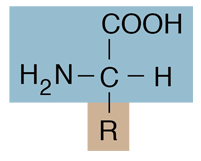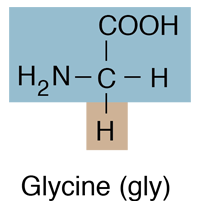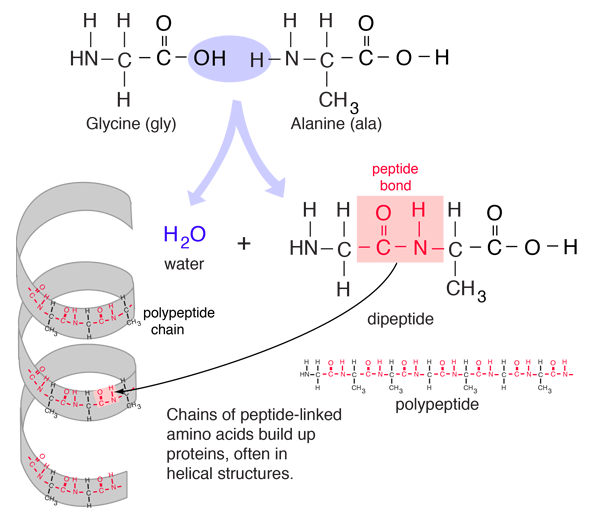Amino Acids
Amino acids are organic compounds which contain both an amino group and a carboxyl group.

Amino acids have the general form:
 |
|
 |
Here the COOH is understood to be the carboxyl group shown above. There are 20 amino acids which make up the proteins of living organisms, distinguished by the R-groups. The simplest of the amino acids, glycine, has just H as an R-group. The list of these 20 amino acids at right may be clicked for further information. The single-letter representations of these amino acids are included. Amino acids are the structural elements from which proteins are built. When amino acids bond to each other, it is done in the form of an amide , making a connection which is called a peptide linkage. This can be illustrated with the two simplest amino acids, glycine and alanine. "Amino acids are used to synthesize certain hormones, other amino acids, some neurotransmitters (chemicals used in communication between neurons), and new proteins. These proteins have diverse roles in the body, acting as enzymes, receptors on cell membranes, oxygen transport molecules (hemoglobin), structural components (hair and nails), hormones, antibodies, and muscle proteins."(Audesirks) |
 Active graphic |
According to Tillery, et al., the human body can synthesize all of the amino acids necessary to build proteins except for the ten called the "essential amino acids", indicated by asterisks in the amino acid illustrations. An adequate diet must contain these essential amino acids. Typically, they are supplied by meat and dairy products, but if those are not consumed, some care must be applied to ensuring an adequate supply. They can be supplied by a combination of cereal grains (wheat, corn, rice, etc.) and legumes (beans,peanuts, etc.). Tillery points out that a number of popular ethnic foods involve such a combination, so that in a single dish, one might hope to get the ten essential amino acids. Mexican corn and beans, Japanese rice and soybeans, and Cajun red beans and rice are examples of such fortuitous combinations.
Amino acids can form in either left-handed or right-handed molecular symmetry, but it is notable that all life on the Earth contains left-handed amino acids as the building blocks of its proteins. This fact makes remarkable the amino acids found in the Murchison meteorite, which were nearly equal mixtures of left- and right-handed amino acids for the central portion. That equal population itself would have been convincing evidence of its extra-terrestrial origin even if it had not been observed to impact near Murchison, Australia in 1969. There is some element of mystery why the Murchison meteorite did show some elevation of L-amino acid after contamination was accounted for, as did meteorite GRA 95229 from Antarctica.
Wiki: amino acid
Biochemical concepts
Chemistry concepts
References
Shipman, Wilson and Todd
Ch 15
Tillery, Enger and Ross
Ch 14
Audesirk & Audesirk
Ch 29
Matthews, van Holde, Ahern
Ch 5
| HyperPhysics*****Chemistry | R Nave |
